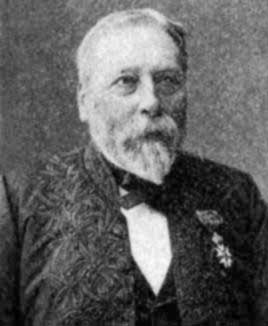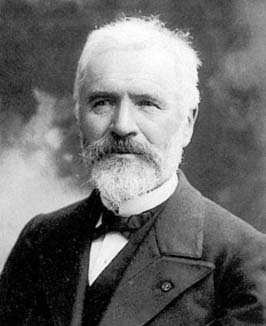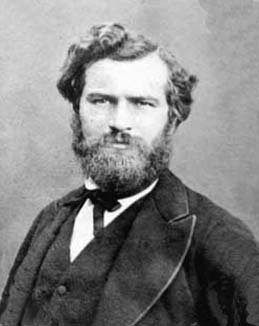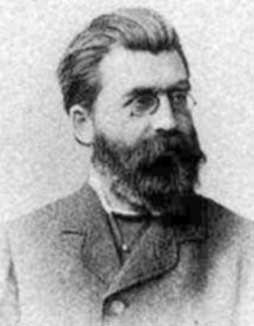<Back to Index>
- Mathematician Joseph Alfred Serret, 1819
- Mathematician Marie Ennemond Camille Jordan, 1838
- Mathematician Eugen Otto Erwin Netto, 1848
PAGE SPONSOR

Joseph Serret graduated from the École Polytechnique in Paris in 1840. He became an entrance examiner for the École Polytechnique in 1848. In 1861 he became professor of celestial mechanics at Collège de France, then two years later he was appointed to the chair of differential and integral calculus at the Sorbonne. Serret joined the Bureau des Longitudes in 1873.
Serret did important work in differential geometry. Together with Bonnet and Bertrand he made major advances in this topic. The fundamental formulae in the theory of space curves are the Frenet - Serret formulae.
In 1860 Serret succeeded Poinsot in the Académie des Sciences. In 1871 he retired to Versailles as his health began to deteriorate.
Serret also worked in number theory, calculus and mechanics. He edited the works of Lagrange which were published in 14 volumes between 1867 and 1892. He also edited the 5th edition of Monge in 1850.

Camille Jordan's father, Esprit - Alexandre Jordan (1800 - 1888), was an engineer who had been educated at the École Polytechnique. Camille's mother, Joséphine Puvis de Chavannes, was the sister of the famous painter Pierre Puvis de Chavannes who was the foremost French mural painter of the second half of the 19th century. Camille's father's family were also quite well known; a grand - uncle also called Ennemond - Camille Jordan (1771 - 1821) achieved a high political position while a cousin Alexis Jordan (1814 - 1897) was a famous botanist.
Jordan studied at the Lycée de Lyon and at the Collège d'Oullins. He entered the École Polytechnique to study mathematics in 1855. This establishment provided training to be an engineer and Jordan, like many other French mathematicians of his time, qualified as an engineer and took up that profession. Cauchy in particular had been one to take this route and, like Cauchy, Jordan was able to work as an engineer and still devote considerable time to mathematical research. Jordan's doctoral thesis was in two parts with the first part Sur le nombre des valeurs des fonctions being on algebra. The second part entitled Sur des periodes des fonctions inverses des intégrales des différentielles algebriques was on integrals of the form ∫ u dz where u is a function satisfying an algebraic equation f (u, z) = 0. Jordan was examined on 14 January 1861 by Duhamel, Serret and Puiseux. In fact the topic of the second part of Jordan's thesis had been proposed by Puiseux and it was this second part which the examiners preferred. After the examination he continued to work as an engineer, first at Privas, then at Chalon - sur - Saône, and finally in Paris.
Jordan married Marie - Isabelle Munet, the daughter of the deputy mayor of Lyon, in 1862. They had eight children, two daughters and six sons.
From 1873 he was an examiner at the École Polytechnique where he became professor of analysis on 25 November 1876. He was also a professor at the Collège de France from 1883 although until 1885 he was at least theoretically still an engineer by profession. It is significant, however, that he found more time to undertake research when he was an engineer. Most of his original research dates from this period.
Jordan was a mathematician who worked in a wide variety of different areas essentially contributing to every mathematical topic which was studied at that time. His Complete Works are in four volumes and the range of topics is seen from the contents of these. Volumes 1 and 2 contain Jordan's papers on finite groups, Volume 3 contains his papers on linear and multilinear algebra and on the theory of numbers, while Volume 4 contains papers on the topology of polyhedra, differential equations, and mechanics.
Topology (called analysis situs at that time) played a major role in some of his first publications which were a combinatorial approach to symmetries. He introduced important topological concepts in 1866 built on his knowledge of Riemann's work in topology but not the work by Möbius for he was unaware of it. Jordan introduced the notion of homotopy of paths looking at the deformation of paths one into the other. He defined a homotopy group of a surface without explicitly using group terminology.
Jordan was particularly interested in the theory of finite groups. In fact this is not really an accurate statement, for it would be reasonable to argue that before Jordan began his research in this area there was no theory of finite groups. It was Jordan who was the first to develop a systematic approach to the topic. It was not until Liouville republished Galois's original work in 1846 that its significance was noticed at all. Serret, Bertrand and Hermite had attended Liouville's lectures on Galois theory and had begun to contribute to the topic but it was Jordan who was the first to formulate the direction the subject would take.
To Jordan a group was what we would call today a permutation group; the concept of an abstract group would only be studied later. To give an illustration of the way he tried to build up group theory we will say a little about his contributions to finite soluble groups. The standard way to define such groups today would be to say that they are groups whose composition factors are abelian groups. Indeed Jordan introduced the concept of a composition series (a series of subgroups each normal in the preceding with the property that no further terms could be added to the series so that it retains that property). The composition factors of a group G are the groups obtained by computing the factor groups of adjacent groups in the composition series. Jordan proved the Jordan - Hölder theorem, namely that although groups can have different composition series, the set of composition factors is an invariant of the group.
Although the classification of finite abelian groups is straightforward, the classification of finite soluble groups is well beyond mathematicians today and for the foreseeable future. Jordan, however, clearly saw this as an aim of the subject, even if it was not one which might ever be solved. He made some remarkable contributions to how such a classification might proceed setting up a recursive method to determine all soluble groups of order n for a given n.
A second major piece of work on finite groups was the study of the general linear group over the field with p elements, p prime. He applied his work on classical groups to determine the structure of the Galois group of equations whose roots were chosen to be associated with certain geometrical configurations.
His work on group theory done between 1860 and 1870 was written up into a major text Traité des substitutions et des équations algebraique which he published in 1870. This treatise gave a comprehensive study of Galois theory as well as providing the first ever group theory book. For this work he was awarded the Poncelet Prize of the Académie des Sciences. The treatise contains the 'Jordan normal form' theorem for matrices, not over the complex numbers but over a finite field. He appears not to have known of earlier results of this type by Weierstrass. His book brought permutation groups into a central role in mathematics and, until Burnside wrote his famous group theory text nearly 30 years later, this work provided the foundation on which the whole subject was built. It would also be fair to say that group theory was one of the major areas of mathematical research for 100 years following Jordan's fundamental publication.
Jordan's use of the group concept in geometry in 1869 was motivated by studies of crystal structure. He considered the classification of groups of Euclidean motions. His work had gained him a wide international reputation and both Sophus Lie and Felix Klein visited him in Paris in 1870 to study with him. Jordan's interest in groups of Euclidean transformations in three dimensional space influenced Lie and Klein in their own theories of continuous and discontinuous groups.
The publication of Traité des substitutions et des équations algebraique did not mark the end of Jordan's contribution to group theory. He went on over the next decade to produce further results of fundamental importance. He studied primitive permutation groups and proved a finiteness theorem. He defined the class of a subgroup of the symmetric group to be c > 1 if c was the smallest number such that the subgroup had an element moving c points. His finiteness theorem showed that for a given c there are only finitely many primitive groups with class c other than the symmetric and alternating groups.
Generalizing a result of Fuchs on linear differential equations, Jordan was led to study the finite subgroups of the general linear group of n × n matrices over the complex numbers. Although there are infinite families of such finite subgroups, Jordan found that they were of a very specific group theoretic structure which he was able to describe.
Another generalization, this time of work by Hermite on quadratic forms with integral coefficients, led Jordan to consider the special linear group of n × n matrices of determinant 1 over the complex numbers acting on the vector space of complex polynomials in n indeterminates of degree m.
Jordan is best remembered today among analysts and topologists for his proof that a simply closed curve divides a plane into exactly two regions, now called the Jordan curve theorem. It was only his increased understanding of mathematical rigor which made him realize that a proof of such a result was necessary. He also originated the concept of functions of bounded variation and is known especially for his definition of the length of a curve. These concepts appears in his Cours d'analyse de l'École Polytechnique first published in three volumes between 1882 and 1887. The second edition appeared in 1893 while the Jordan curve theorem appeared in the third edition of the text which appeared between 1909 and 1915.
Of course by 1882, when the first volume was published, Jordan was lecturing at the École Polytechnique and the book was written as a text for the students there. In some respects this is a little strange since it is a rigorous analysis text built on top of the attempts to put the topic on a firm foundation begun by Cauchy and given considerable impetus by Weierstrass. However, the courses at the École Polytechnique were supposed to train students to become civil and military engineers and this does not seem to be the approach which one would take trying to teach applications of the calculus to engineers. There had been a tradition of rigorous analysis at the École Polytechnique begun, of course, by Cauchy himself. Jordan was aware that his work was at a level that would be somewhat inappropriate for engineering students for he once said to Lebesgue that he called it "École Polytechnique analysis course" since:-
... one puts that on the cover to please the publisher...
Gispert - Chambaz contrasts the way that topological concepts are treated by Jordan in the first and second editions of the book. In the first edition most of the topological concepts are dealt with in a supplement to Volume 3. However between the editions Jordan had taught more advanced courses on analysis at the Collège de France and this may have influenced him to put set topology right up front in the second edition. In this respect one can see the second edition as setting a tone for analysis textbooks which continues today.
Among Jordan's many contributions to analysis we should also mention his generalization of the criteria for the convergence of a Fourier series.
The Journal de Mathématiques Pure et Appliquées was a leading mathematical journal and played a very significant part in the development of mathematics throughout the 19th century. It was usually known as the Journal de Liouville since Liouville had founded the journal in 1836. Liouville died in 1882 and in 1885 Jordan became editor of the Journal, a role he kept for over 35 years until his death.
In 1912 Jordan retired from his positions. The final years of his life were saddened, however, because of World War I which began in 1914. Between 1914 and 1916 three of his six sons were killed in the war. Of his three remaining sons, Camille was a government minister, Edouard was a professor of history at the Sorbonne, and the third son was an engineer.
Among the honors given to Jordan was his election to the Académie des Sciences on 4 April 1881. On 12 July 1890 he became an officer of the Légion d'honneur. He was the Honorary President of the International Congress of Mathematicians at Strasbourg in September 1920.
Finally we should note some rather confusing facts. Although given Jordan's work on matrices and the fact that the Jordan normal form is named after him, the Gauss - Jordan pivoting elimination method for solving the matrix equation Ax= b is not. The Jordan of Gauss - Jordan is Wilhelm Jordan (1842 to 1899) who applied the method to finding squared errors to work on surveying. Jordan algebras are called after the German physicist and mathematician Pascual Jordan (1902 to 1980).

Eugen Netto's father was Heinrich Netto, an official at the Franckesche Stiftung at Halle. The Stiftung was a Protestant religious institute which included a school for the poor, an orphanage, a medical center, and publishing house. Eugen's mother was Sophie Neumann. Up to the age of ten Eugen attended a school in Halle, but from that time he went to a Gymnasium in Berlin.
Netto was fortunate to have an outstanding teacher of mathematics at the Berlin Gymnasium in Karl Heinrich Schellbach, who had been Eisenstein's mathematics teacher. It was Schellbach who showed Netto the excitement of mathematics and from that time on mathematics was clearly the only topic that he considered. After graduating from the Gymnasium in 1866, Netto entered the University of Berlin to study mathematics. He again had some inspiring teachers in Kronecker, Weierstrass and Kummer.
Netto graduated from Berlin in 1870 having worked specifically under Weierstrass and Kummer. It was in fact Weierstrass who examined his final dissertation. There was no immediate university appointment for Netto, however, and he taught in a Gymnasium in Berlin for nine years before being appointed as extraordinary professor at the University of Strasbourg in 1879.
It was the French - German war of 1870 - 71, which ended with Alsace being
annexed by the German empire, which had led to a German university being
set up in Strasbourg. In 1872 the so-called Kaiser - Wilhelms - Universität
was opened in Strasbourg. The Mathematisches Seminar there was directed
by Christoffel and Reye, and Netto took part in this seminar.
After three years at the University of Strasbourg Weierstrass recommended that Netto be appointed an extraordinary professor at the University of Berlin and he took up the appointment in 1882. There he taught courses on advanced algebra, the calculus of variations, mechanics, Fourier series, and synthetic geometry. Netto held this post in Berlin until 1888 when he was appointed ordinary professor at the University of Giessen. He held this post for twenty - five years until his retirement in 1913.
In 1878 he attempted the second general proof of the invariance of 'dimension' but, like the first by Thomae, it was not completely satisfactory. Despite this, Netto's "proof" was widely accepted as providing a solution to the dimension problem until Jurgens' criticism in 1899 of Netto's proof. Jurgens similarly criticized a proof of the invariance of 'dimension' which had been given by Cantor.
Cantor showed in 1878 that the unit interval I can be mapped bijectively onto the unit square I2. In the following year Netto showed that such a mapping cannot be a continuous function. These results by Cantor and Netto are starting points for the investigations of space - filling curves which are an active research area today.
Netto made major steps towards abstract group theory when he combined permutation group results and groups in number theory. He did not however include matrix groups! He published this work in his book Substitutionentheorie und ihre Anwendung auf die Algebra in Berlin in 1882 described by Biermann as:-
... a milestone in the development of abstract group theory.
He further contributed to the development of group theory in other papers. In particular, in 1877 Netto had given new proofs of the Sylow's theorems.